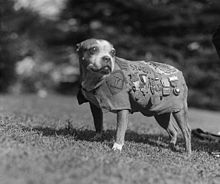Sergeant Stubby
| Sergeant Stubby | |
|---|---|

Sergeant Stubby
|
|
| Born | 1916 or 1917 |
| Died | March 16, 1926 (aged 9–10) |
| Place of display | Smithsonian - "The Price of Freedom" exhibition |
| Allegiance | United States of America |
| Service/branch | United States Army |
| Rank | Sergeant |
| Unit | 102nd Infantry Regiment 26th (Yankee) Division |
| Battles/wars | World War I |
| Awards | Humane Education Society Gold Medal Wound stripe |
| Other work | Georgetown Hoyas' mascot |
Sergeant Stubby (July 21, 1916 – March 16, 1926), has been called the most decorated war dog of World War I and the only dog to be nominated for rank and then promoted to sergeant through combat, a claim having no official documentary evidence, but recognized in connection with an exhibition at the Smithsonian Institution. He was the official mascot of the 102nd Infantry Regiment (United States), assigned to the 26th (Yankee) Division. Stubby served for 18 months and participated in seventeen battles on the Western Front. He saved his regiment from surprise mustard gas attacks, found and comforted the wounded, and once caught a German soldier by the seat of his pants, holding him there until American soldiers found him. Back home, his exploits were front page news in major newspapers.
Stubby was described in contemporaneous news items as a Bull Terrier or Boston Terrier. Describing him as a dog of "uncertain breed", Ann Bausum wrote that "The brindle-patterned pup probably owed at least some of his parentage to the evolving family of Boston Terriers, a breed so new that even its name was in flux: Boston Round Heads, American Bull Terriers, and Boston Bull Terriers." Stubby was found wandering the grounds of Yale University campus in New Haven, Connecticut in July 1917 while members of the 102nd Infantry were training. The dog hung around as the men drilled and one soldier, Corporal Robert Conroy, developed a fondness for the dog. When it came time for the outfit to ship out, Conroy hid Stubby on board the troop ship. As they were getting off the ship in France, he hid Stubby under his overcoat without detection. Upon discovery by Conroy's commanding officer, Stubby saluted him as he had been trained to in camp, and the commanding officer allowed the dog to stay on board.
Stubby served with the 102nd Infantry Regiment in the trenches in France for 18 months and participated in four offensives and 17 battles. He entered combat on February 5, 1918 at Chemin des Dames, north of Soissons, and was under constant fire, day and night for over a month. In April 1918, during a raid to take Schieprey, Stubby was wounded in the foreleg by the retreating Germans throwing hand grenades. He was sent to the rear for convalescence, and as he had done on the front was able to improve morale. When he recovered from his wounds, Stubby returned to the trenches. He ultimately had two wound stripes.
...
Wikipedia
